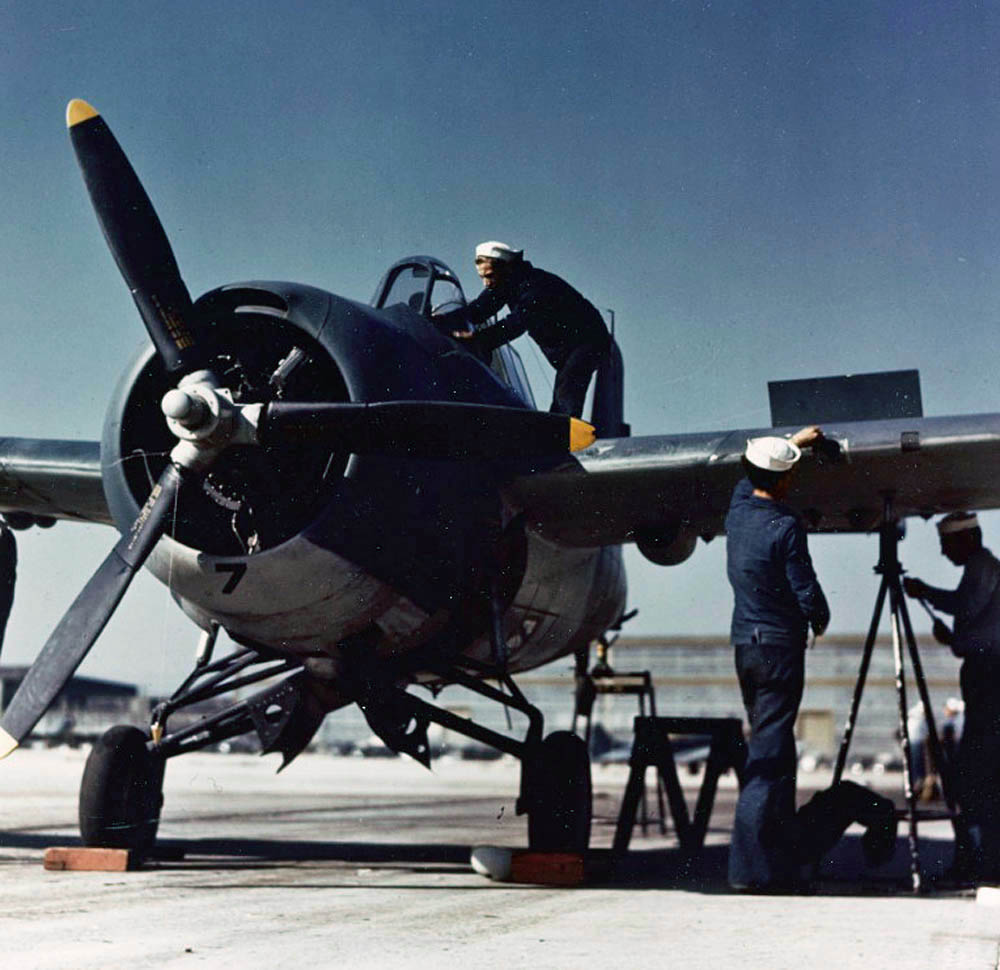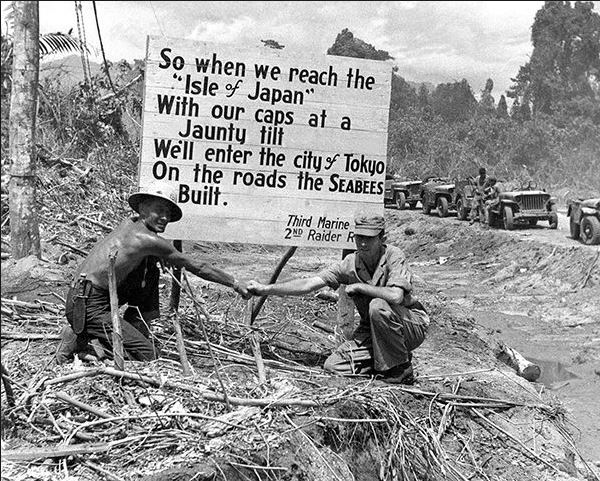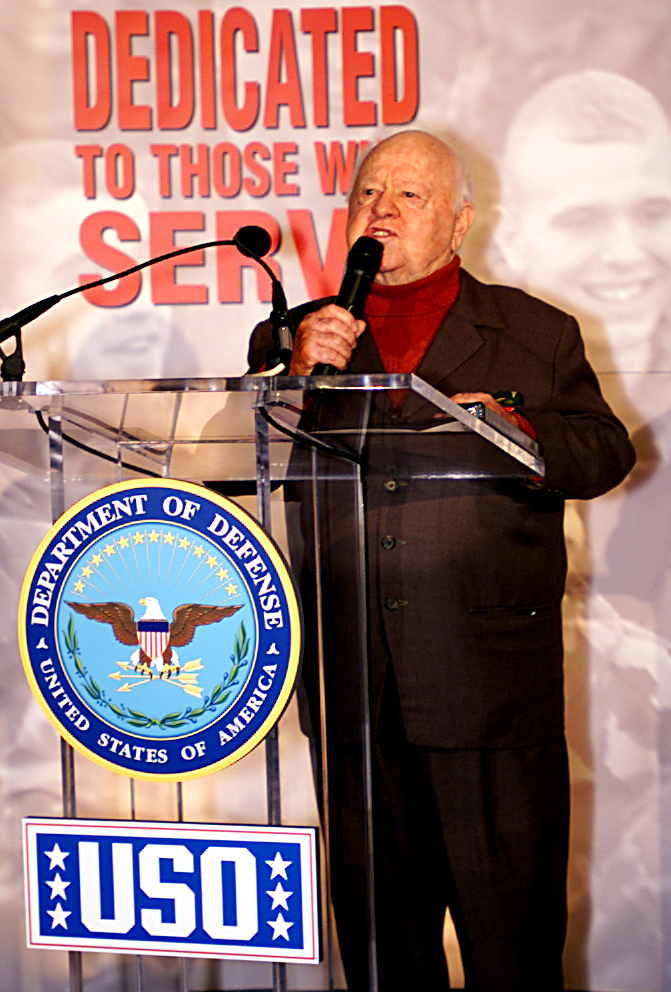|
Ponam Island
Ponam Island with ruway and base. Ponam Island is located off the north coast of Manus Island in Papua New Guinea. The Ponam language is spoken on the island. The Ponam Airfield was built by the US Navy 78th Naval Construction Battalion "Seabees" between June to August 1944. As half of the work area was swamp, coral was blasted and dredged from the ocean bed and used as landfill. During the Admiralty Islands campaign, it was used as a fighter base to provide repair and overhaul facilities for carrier aircraft, as part of Manus Naval Base. The USO entertainer Bob Hope stop at Ponam Airfield in 1944 with an unscheduled show with troops from surrounding bases. Ponam Airfield **Based at Ponam Airfield was: **78th Naval Construction Battalion **140th Battalion ** ACORN 28 - Seabee unit ** VMF-312 (24 x FG Vought F4U Corsair unit) **VP-130 (15 Lockheed Ventura V-1unit) **VC-75 (Grumman F4F Wildcat unit) **Carrier Aircraft Service Unit 42 **Carrier Aircraft Service Unit 13 **Car ... [...More Info...] [...Related Items...] OR: [Wikipedia] [Google] [Baidu] |
Admiralty Islands
The Admiralty Islands are an archipelago group of 18 islands in the Bismarck Archipelago, to the north of New Guinea in the South Pacific Ocean. These are also sometimes called the Manus Islands, after the largest island. These rainforest-covered islands form part of Manus Province, the smallest and least-populous province of Papua New Guinea, in its Islands Region. The total area is . Many of the Admiralty Islands are atolls and uninhabited. Islands The larger islands in the center of the group are Manus Island and Los Negros Island. The other larger islands are Tong Island, Pak Island, Rambutyo Island, Lou Island, and Baluan Island to the east, Mbuke Island to the south and Bipi Island to the west of Manus Island. Other islands that have been noted as significant places in the history of Manus include Ndrova Island, Pitylu Island and Ponam Island. Geography The temperature of the Admiralty Islands varies little throughout the year, reaching daily highs of and at night. ... [...More Info...] [...Related Items...] OR: [Wikipedia] [Google] [Baidu] |
Bob Hope
Leslie Townes "Bob" Hope (May 29, 1903 – July 27, 2003) was a British-American comedian, vaudevillian, actor, singer and dancer. With a career that spanned nearly 80 years, Hope appeared in more than 70 short and feature films, with 54 feature films with Hope as star, including a series of seven '' Road to ...'' musical comedy films with Bing Crosby as Hope's top-billed partner. In addition to hosting the Academy Awards show 19 times, more than any other host, Hope appeared in many stage productions and television roles and wrote 14 books. The song "Thanks for the Memory" was his signature tune. Hope was born in the Eltham district of southeast London, he arrived in the United States with his family at the age of four, and grew up near Cleveland, Ohio. After a brief career as a boxer in the late 1910s, Hope began his career in show business in the early 1920s, initially as a comedian and dancer on the vaudeville circuit, before acting on Broadway. Hope began appeari ... [...More Info...] [...Related Items...] OR: [Wikipedia] [Google] [Baidu] |
Pityilu Island
Map Pityilu Island with air base 1944 Pityilu Island is part of Manus Province in northern Papua New Guinea and part of the Admiralty Islands. It is off the northern coast of Manus Island and is nearly 4.8 km long and varies in width from 76 to 198 metres. History Pityilu Island was occupied by the Imperial Japanese forces in 1942. On 30 March 1944, the island was assaulted by the reinforced 1st Squadron of 7th Cavalry of the United States Army. 59 Imperial Japanese were killed and 8 cavalrymen were killed with 6 were wounded in the assault. Pityilu Island was selected to become an airstrip for the use of the United States Navy with a Rest & Recreation facility designed to accommodate up to 10,000 servicemen. The facilities were constructed by the 140th Naval Construction Battalion in June 1944. Pityilu Airstrip consisted of a single runway, made of crushed coral x . that was built by the 71st CB as part of Manus Naval Base. The Navy also had an aircraft carrier fighte ... [...More Info...] [...Related Items...] OR: [Wikipedia] [Google] [Baidu] |
Carrier Aircraft Service Units
US Navy K-class blimp Carrier Aircraft Service Units (CASU) were United States Navy units formed during World War II for the Pacific War to support naval aircraft operations. From 1942 to 1946, 69 Carrier Aircraft Service Units were formed to repair and maintain aircraft. The first unit was deployed to Naval Station Pearl Harbor. The CASU-11, was deployed on January 22, 1943 at Naval Air Station San Diego. During the war the Navy lacked enough aircraft carriers to complete all the operational requirements. History In 1942, Ewa Field at Naval Base Hawaii became a major United States Marine Corps and US Navy aviation training facility for Carrier Aircraft Service Units (CASU). Flight crews and air mechanics trained at Ewa Field for the upcoming Pacific War, including Battles at Wake Island, Guadalcanal, and Midway. Aircraft mechanics of Carrier Aircraft Service Units traveled with the island hopping troops as new airfields were built across the Western Pacific Ocean. The many ... [...More Info...] [...Related Items...] OR: [Wikipedia] [Google] [Baidu] |
Grumman F4F Wildcat
The Grumman F4F Wildcat is an American carrier-based fighter aircraft that entered service in 1940 with the United States Navy, and the British Royal Navy where it was initially known as the Martlet. First used by the British in the North Atlantic, the Wildcat was the only effective fighter available to the United States Navy and Marine Corps in the Pacific Theater during the early part of the Second World War. The disappointing Brewster Buffalo was withdrawn in favor of the Wildcat and replaced as aircraft became available. With a top speed of , the Wildcat was outperformed by the faster (), more maneuverable, and longer-ranged Mitsubishi A6M Zero. US Navy pilots, including John "Jimmy" Thach, a pioneer of fighter tactics to deal with the A6M Zero, were greatly dissatisfied with the Wildcat's inferior performance against the Zero in the battles of the Coral Sea and Midway. The Wildcat has a claimed air combat kill-to-loss ratio of 5.9:1 in 1942 and 6.9:1 for the entire war.Po ... [...More Info...] [...Related Items...] OR: [Wikipedia] [Google] [Baidu] |
Lockheed Ventura
The Lockheed Ventura is a twin-engine medium bomber and patrol bomber of World War II. The Ventura first entered combat in Europe as a bomber with the RAF in late 1942. Designated PV-1 by the United States Navy (US Navy), it entered combat in 1943 in the Pacific. The bomber was also used by the United States Army Air Forces (USAAF), which designated it the Lockheed B-34 (''Lexington'') and B-37 as a trainer. British Commonwealth forces also used it in several guises, including antishipping and antisubmarine search and attack. The Ventura was developed from the Lockheed Model 18 Lodestar transport, as a replacement for the Lockheed Hudson bombers then in service with the Royal Air Force. Used in daylight attacks against occupied Europe, they proved to have weaknesses and were removed from bomber duty and some used for patrols by Coastal Command. After USAAF monopolization of land-based bombers was removed, the US Navy ordered a revised design which entered service as the PV-2 H ... [...More Info...] [...Related Items...] OR: [Wikipedia] [Google] [Baidu] |
Vought F4U Corsair
The Vought F4U Corsair is an American fighter aircraft which saw service primarily in World War II and the Korean War. Designed and initially manufactured by Chance Vought, the Corsair was soon in great demand; additional production contracts were given to Goodyear, whose Corsairs were designated FG, and Brewster, designated F3A. The Corsair was designed and operated as a carrier-based aircraft, and entered service in large numbers with the U.S. Navy in late 1944 and early 1945. It quickly became one of the most capable carrier-based fighter-bombers of World War II. Some Japanese pilots regarded it as the most formidable American fighter of World War II and its naval aviators achieved an 11:1 kill ratio. Early problems with carrier landings and logistics led to it being eclipsed as the dominant carrier-based fighter by the Grumman F6F Hellcat, powered by the same Double Wasp engine first flown on the Corsair's initial prototype in 1940. Instead, the Corsair's early deployme ... [...More Info...] [...Related Items...] OR: [Wikipedia] [Google] [Baidu] |
Seabees In World War II
When World War II broke out the United States Naval Construction Battalions (Seabees) did not exist. The logistics of a two theater war were daunting to conceive. Rear Admiral Moreell completely understood the issues. What needed to be done was build staging bases to take the war to the enemy, across both oceans, and create the construction force to do the work. Naval Construction Battalions were first conceived at Bureau of Yards and Docks (BuDocks) in the 1930s. The onset of hostilities clarified to Radm. Moreell the need for developing advance bases to project American power. The solution: tap the vast pool of skilled labor in the U.S. Put it in uniform to build anything, anywhere under any conditions and get the Marine Corps to train it. The first volunteers came skilled. To obtain these tradesmen, military age was waived to age 50. It was later found that several past 60 had managed to get in. Men were given advanced rank/pay based upon experience making the Seabees ... [...More Info...] [...Related Items...] OR: [Wikipedia] [Google] [Baidu] |
USO Entertainer
The United Service Organizations Inc. (USO) is an American nonprofit-charitable corporation that provides live entertainment, such as comedians, actors and musicians, social facilities, and other programs to members of the United States Armed Forces and their families. Since 1941, it has worked in partnership with the Department of War, and later with the Department of Defense (DoD), relying heavily on private contributions and on funds, goods, and services from various corporate and individual donors. Although it is congressionally chartered, it is not a government agency. Founded during World War II, the USO sought to be the GI's "home away from home" and began a tradition of entertaining the troops and providing social facilities. Involvement in the USO was one of the many ways in which the nation had come together to support the war effort, with nearly 1.5 million people having volunteered their services in some way. The USO initially disbanded in 1947, but was reviv ... [...More Info...] [...Related Items...] OR: [Wikipedia] [Google] [Baidu] |
Manus Naval Base
Manus Naval Base, Naval supply depot with piers and quonset Hut warehouses on September 18, 1945 Manus Naval Base was a number of bases built after the World War II Battle of Manus by United States Navy on the Manus Island and a smaller island just east, Los Negros Island in the Admiralty Islands chain. The major naval base construction started with the Los Negros landings on February 28, 1944. The Navy repaired and did the expansion of the airfields on the Admiralty Islands. United States Navy Seabee built or repaired the facilities on the islands. The large Manus Naval Base, also called the Admiralty Island base, supported United States Seventh Fleet, Southwest Pacific command, and part of the Pacific Fleet. The base was abandoned by the US Navy after the war. History Japanese called Los Negros Island the Hyane Island and had built some facilities on the two islands. Manus Island was picked for a major air and sea base as it was near Empire of Japan strong points: 387 m ... [...More Info...] [...Related Items...] OR: [Wikipedia] [Google] [Baidu] |









